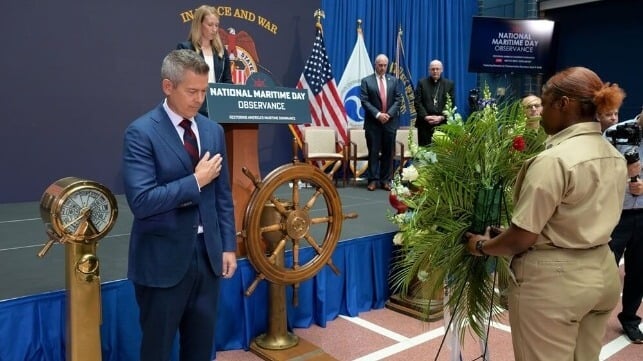U.S. Celebrates National Maritime Day With an Eye to the Future

On Thursday, American shipping celebrated National Maritime Day, a recognition of the industry's past - and thanks to a resurgence of interest among federal policymakers, a hopeful outlook for the industry's future.
Congress declared National Maritime Day in 1933, and it selected May 22 to commemorate the path-setting voyage of the SS Savannah from the United States to the UK. It was the first steamship crossing of the Atlantic, and it remains a symbol of American maritime ingenuity.
The day is an annual opportunity to recognize the sector's contributions to the economy and to national defense. American mariners, shipbuilders and operators have kept the nation safe and prosperous "in peace and war" since the days of the Founding Fathers; they have served during the United States' finest hours - not least during the Second World War, when 9,500 American mariners paid with their lives in pursuit of victory. In that era, joining the U.S. merchant marine was an act of bravery: Nazi U-boats and frigid Atlantic waters led to a higher casualty rate among mariners than among servicemembers in any of the armed forces.
On Thursday, seaports around the country held local events in recognition of National Maritime Day. At Port of Galveston, a daylong event (sponsored by Wallenius Wilhelmsen) invited members of the public to come down to the docks to learn about maritime job opportunities and to tour a U.S. Coast Guard cutter, USCGC Hawk.
In Washington, D.C., the U.S. Department of Transportation held a memorial ceremony to honor mariners past and present. Secretary Sean Duffy launched the event with remarks on restoring American maritime dominance on the global stage.
???? Happening now:
— U.S. Department of Transportation (@USDOT) May 22, 2025
We’re live for our National Maritime Day Observance with @SecDuffy, honoring the mariners who keep America’s economy and security moving.
Restoring America’s Maritime Dominance ???????? ???? https://t.co/I0Y08LQIVw
"Maritime is back, baby!" said Duffy, thanking President Donald Trump for a recent executive order to support American maritime. Duffy noted that China produced 1,800 merchant ships in 2022 - half the tonnage built in the world last year - while U.S. yards built five deep-draft hulls. "We used to be the best. But we've let this industry peter out, taper off, and we've let our adversaries stand up and take the lead," he said. "If you want to be a global superpower, you need to build ships in your country, and you need to be able to sail those ships with your mariners."
The Trump administration and its allies in Congress are moving to provide more support to the industry. The recent executive order directs the creation of a Maritime Action Plan (MAP) to revitalize U.S. maritime industries, and it encourages the Office of the United States Trade Representative (USTR) to take action on anticompetitive Chinese shipbuilding policies (as it is actively pursuing).
It also proposes a new Maritime Security Trust Fund for U.S. shipping, funded by tariffs, fines, fees or other dedicated revenue streams, and it encourages new investment in infrastructure at the U.S. Merchant Marine Academy.
The administration also backs a plan to support deep-sea mining, a new industry that could provide a previously-untapped source of critical minerals - a strategically important alternative to imports from China.
In Congress, the recently reintroduced SHIPS Act calls for 250 U.S.-flagged ships within 10 years through the creation of a Strategic Commercial Fleet program. To drive this expansion of U.S. merchant shipping, the act would require a portion of U.S. imports from China to be moved on U.S.-flagged ships starting in 2030. The bill has high-level support on both sides of the aisle, and is among the most prominent and far-reaching legislative efforts to revive American maritime's fortunes in decades.
